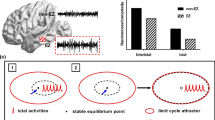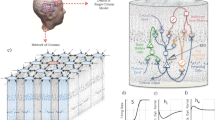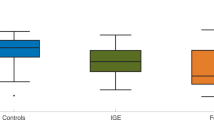Abstract
To understand basic functional mechanisms that cause epileptic seizures, the paper discusses some key features of theoretical brain functioning models. The hypothesis is put forward that a plausible reason for seizures is pathological feedback in brain circuitry. The analysis of such circuitry has an interesting physical interpretation and may be used to cure epilepsy.
Similar content being viewed by others
References
P. Kwan and M. J. Brodie, “Early identification of refractory epilepsy,” New Engl. J. Medicine, 342, 314–319 (2000).
J. F. Kerrigan, B. Litt, R. S. Fisher, S. Cranstoun, J. A. French, D. E. Blum, M. Dicher, A. Shetter, G. Baltuch, J. Jaggi, S. Krone, M. A. Brodie, M. Rise, and N. Graves, “Electrical stimulation of the anterior nucleus of the thalamus for the treatment of intractable epilepsy,” Epilepsia, 45(4), 346–354 (2004).
E. H. Kossoff, E. K. Ritzl, J. M. Politsky, A. M. Murro, J. R. Smith, R. B. Duckrow, D. D. Spencer, and G. K. Bergey, “Effect of an external responsive neurostimulator on seizures and electrographic discharges during subdural electrode monitoring,” Epilepsia, 45(12), 1560–1567 (2004).
I. Osorio, M.G. Frei, S. Sunderam, J. Giftakis, N. C. Bhavaraju, S. F. Schaffner, and S. B. Wilkinson, “Automated seizure abatement in humans using electrical stimulation,” Annals of Neurology, 57(2), 258–268 (2005).
J. G. Milton, J. Gotman, G. M. Remillard, and F. Andermann, “Timing of seizure recurrence in adult epileptic patients: a statistical analysis,” Epilepsia, 28, 471–478 (1987).
W. Penfield, “The evidence for a cerebral vascular mechanism in epilepsy,” Ann. Int. Med., 7, 303–310 (1933).
W. G. Lennox, Science and Seizures, Harper, New York (1946).
L. D. Iasemidis, H. P. Zaveri, J. C. Sackellares, W. J. Williams, and T. W. Hood, “Nonlinear dynamics of electrocorticographic data,” J. Clinical Neurophysiology, No. 5 (1988).
L. D. Iasemidis and J. C. Sackellares, “The temporal evolution of the largest Lyapunov exponent on the human epileptic cortex,” in: D. W. Duke and W. S. Pritchard (eds.), Measuring Chaos in the Human Brain, World Scientific, Singapore (1991), pp. 49–82.
L. D. Iasemidis, D. S. Shiau, W. Chaovalitwongse, J. C. Sackellares, P. M. Pardalos, J. C. Principe, P. R. Carney, A. Prasad, B. Veeramani, and K. Tsakalis, “Adaptive epileptic seizure prediction system,” IEEE Trans. Biomedical Engineering, 50, 616–627 (2003).
L. D. Iasemidis, D. S. Shiau, J. C. Sackellares, P. M. Pardalos, and A. Prasad, “Dynamical resetting of the human brain at epileptic seizures: application of nonlinear dynamics and global optimization techniques,” IEEE Trans. Biomedical Engineering, 51, 493–506 (2004).
K. Lehnertz, G. Widman, and C. E. Elger, “Predicting seizures of mesial temporal and neocortical origin,” Epilepsia, 39 (1998).
K. Lehnertz, R. Andrzejak, J. Arnhold, T. Kreuz, F. Morman, C. Rieke, G. Widman, and C. E. Elger, “Nonlinear EEG analysis in epilepsy: Its possible use for interictal focus localization, seizure anticipation and prevention,” J. Clinical Neurophysiology, 18, 209–222 (2001).
H. Stoegbauer, L. Yang, P. Grassberger, R. G. Andrzejak, T. Kreuz, A. Kraskov, C. E. Elger, and K. Lehnertz, “Lateralization of the focal hemisphere in mesial temporal lobe epilepsy using independent component analysis,” Epilepsia, 43 (2002).
M. Le Van Quyen, C. Adam, M. Baulac, J. M. Martinerie, and F. J. Varela, “Nonlinear interdependencies of EEG signals in human intracranially recorded temporal lobe seizures,” Brain Research, 792, 24–40 (1998).
M. Le Van Quyen, J. M. Martinerie, V. Navarro, M. Baulac, and F. J. Varela, “Characterizing neurodynamic changes before seizures,” J. Clinical Neurophysiology, 18, 191–208 (2001).
L. B. Good, S. Sabesan, L. D. Iasemidis, and D. M. Treiman, “Real-time control of epileptic seizures,” Proc. 3rd European Medical and Biological Engineering Conf., Prague, Czech Republic (2005).
L. D. Iasemidis, A. Prasad, J. C. Sackellares, P. M. Pardalos, and D. S. Shiau, “On the prediction of seizures, hysteresis and resetting of the epileptic brain: insights from models of coupled chaotic oscillators,” in: T. Bountis and S. Pneumatikos (eds.), Order and Chaos, Publ. House of K. Sfakianakis, Thessaloniki, Greece, p. 283–305, Proc. 14th Summer School on Nonlinear Dynamics: Chaos and Complexity, Patras, Gfreece (2001).
A. Skarda and W. J. Freeman, “How brains make chaos in order to make sense of the world?” Behav. Brain Sci., 10, 161–195 (1987).
B. D. O. Anderson, “Adaptive systems, lack of persistency of excitation and bursting phenomenon,” Automatica, 21, 247–258 (1985).
W. A. Sethares, Jr., C. R. Johnson, and C. E. Rohrs, “Bursting in adaptive hybrids,” IEEE Trans. Commun., C-35, 791–799 (1989).
K. S. Tsakalis, “Performance limitations of adaptive parameter estimation and system identification algorithms in the absence of excitation,” Automatica, 32, No. 4, 549–560 (1996).
K. S. Tsakalis, N. Chakravarthy, and L. D. Iasemidis, “Control of epileptic seizures: Model of chaotic oscillator networks,” Proc. IEEE CDC2005, Seville, Spain (2005).
R. D. Traub and A. Bibbig, “A model of high-frequency ripples in the hippocampus, based on synaptic coupling plus axon-axon gap junctions between pyramidal neurons,” J. Neurosci., 20, 2086–2093 (2000).
F. L. Da Silva, W. Blanes, S. N. Kalitzin, J. Parra, P. Suffczynski, and D. N. Velis, “Epilepsies as dynamical diseases of brain systems: basic models of the transition between normal and epileptic activity,” Epilepsia, 44(Suppl. 12), 72–83 (2003).
J. M. Carlson and J. Doyle, “Highly optimized tolerance: a mechanism for power laws in designed systems,” Physical Review E., 60, No. 2, 1412–1427 (1999).
J. Doyle and J. M. Carlson, “Power laws, highly optimized tolerance, and generalized source coding,” Physical Review Letters, 84, No. 24, 5656–5659 (2000).
K. Tsakalis, “Prediction and control of epileptic seizures,” in: Proc. Intern. Conf. and Summer School Complexity in Sci. and Society European Advanced Studies Conference V, July 14–26, Patras and Ancient Olympia, Greece (2004).
K. J. Astrom and L. Rundqwist, “Integrator windup and how to avoid it,” Proc. American Control Conf., Pittsburgh (1989), pp. 1693–1968.
E. Grassi, K. Tsakalis, S. Dash, S. V. Gaikwad, W. MacArthur, and G. Stein, “Integrated identification and PID controller tuning by frequency loop-shaping,” IEEE Trans. Contr. Systems Technology, 9, No. 2, 285–294 (2001).
Author information
Authors and Affiliations
Additional information
The paper is dedicated to the 70th birthday of Academician I. V. Sergienko.
Published in Kibernetika i Sistemnyi Analiz, No. 4, pp. 26–40, July–August 2006.
Rights and permissions
About this article
Cite this article
Tsakalis, K., Chakravarthy, N., Sabesan, S. et al. A feedback control systems view of epileptic seizures. Cybern Syst Anal 42, 483–495 (2006). https://doi.org/10.1007/s10559-006-0087-2
Received:
Issue Date:
DOI: https://doi.org/10.1007/s10559-006-0087-2




